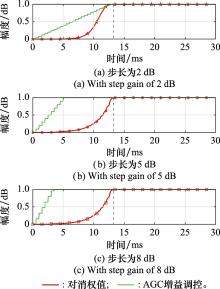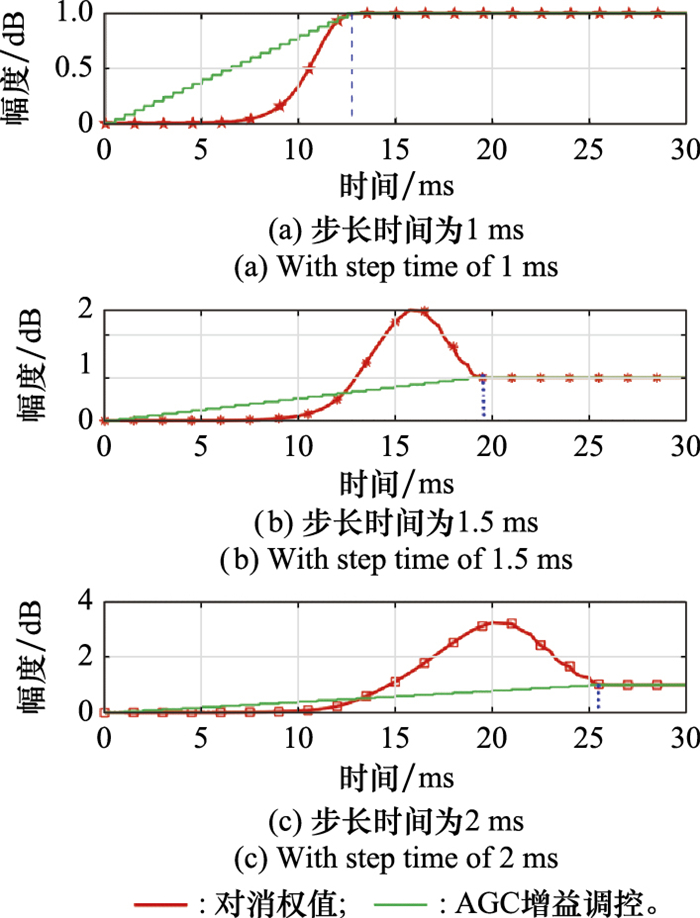Systems Engineering and Electronics ›› 2024, Vol. 46 ›› Issue (12): 3981-3991.doi: 10.12305/j.issn.1001-506X.2024.12.06
• Electronic Technology • Previous Articles
Modeling and analysis of automatic gain control for non-cooperative interference cancellation performance
Ze WANG1,2, Fangmin HE1,2, Qiaran LU1,2, Yunshuo ZHANG1,2, Zheyu LI1,2, Jin MENG1,2, Yaxing LI1,2,*
- 1. Institute of Military Electrical Science and Technology, Naval Engineering University, Wuhan 420100, China
2. National Key Laboratory of Electromagnetic Energy, Naval Engineering University, Wuhan 420100, China
-
Received:2023-10-25Online:2024-11-25Published:2024-12-30 -
Contact:Yaxing LI
CLC Number:
Cite this article
Ze WANG, Fangmin HE, Qiaran LU, Yunshuo ZHANG, Zheyu LI, Jin MENG, Yaxing LI. Modeling and analysis of automatic gain control for non-cooperative interference cancellation performance[J]. Systems Engineering and Electronics, 2024, 46(12): 3981-3991.
share this article
| 1 | 侯建军, 任杰. 非合作寡头博弈与干扰信道资源分配[J]. 北京理工大学学报, 2015, 35 (1): 68- 71. |
| HOU J J , REN J . Non-cooperative stackelberg game and resource allocation in interference channels[J]. Journal of Beijing Institute of Technology, 2015, 35 (1): 68- 71. | |
| 2 | CHENG C H , JAMES T S . An introduction to electronic warfare: from the first jamming to machine learning techniques[M]. Beijing: Electronic Industry Press, 2022. |
| 3 | TEGLER J . Electronic warfare[J]. National Defense, 2022, 107 (827): 136- 146. |
| 4 | ZHANG Y S , JIA X . Adaptive interference suppression for DSSS communications based on compressive sensing[J]. International Journal of Communication Systems, 2018, 31 (11): 389- 396. |
| 5 |
QIN H D , HE F M , MENG J , et al. Analysis and optimal design of radio-frequency interference adaptive cancellation system with delay mismatch[J]. IEEE Trans. on Electromagnetic Compatibility, 2019, 61 (6): 2015- 2023.
doi: 10.1109/TEMC.2019.2950718 |
| 6 |
范新峰, 谭志良. 基于数字对消的跟踪干扰抑制方法[J]. 系统工程与电子技术, 2020, 42 (6): 1235- 1240.
doi: 10.3969/j.issn.1001-506X.2020.06.05 |
|
FAN X F , TAN Z L . Tracking interference suppression method based on digital cancellation[J]. Systems Engineering and Electronics, 2020, 42 (6): 1235- 1240.
doi: 10.3969/j.issn.1001-506X.2020.06.05 |
|
| 7 | 孟进, 何方敏, 李亚星, 等. L波段高速跳频数据链非合作干扰对消装置及方法[P]. 中国: CN114513228B, 2022-07-15. |
| MENG J, HE F M, LI Y X, et al. L-band high-speed frequency hopping data link non-cooperative interference cancellation device and method[P]. China: CN114513228B, 2022-07-15. | |
| 8 | 孟进, 王青, 何方敏, 等. Ku和Ka双频段卫通地面站的多频点干扰对消装置及方法[P]. 中国: CN113922889B, 2022-02-22. |
| MENG J, WANG Q, HE F M, et al. Multi frequency interfe-rence cancellation device and method for Ku and Ka dual band ground stations[P]. China: CN113922889B, 2022-02-22. | |
| 9 |
秦焕丁, 孟进, 何方敏, 等. 多抽头结构的宽带射频干扰对消及优化设计[J]. 系统工程与电子技术, 2023, 45 (9): 2681- 2689.
doi: 10.12305/j.issn.1001-506X.2023.09.05 |
|
QIN H D , MENG J , HE F M , et al. Broadband radio frequency interference cancellation and optimization design of multi tap structure[J]. Systems Engineering and Electronics, 2023, 45 (9): 2681- 2689.
doi: 10.12305/j.issn.1001-506X.2023.09.05 |
|
| 10 | 许彤, 陈亚洲, 王玉明, 等. 无人机数据链带内连续波电磁干扰效应研究[J]. 北京理工大学学报, 2021, 41 (10): 1084- 1094. |
| XU T , CHEN Y Z , WANG Y M , et al. Research on in-band continuous wave electromagnetic interference effects of unmanned aerial vehicle data link[J]. Journal of Beijing Institute of Technology, 2021, 41 (10): 1084- 1094. | |
| 11 |
KIHARA T , TAKAHASHI T , YOSHIMURA T . Digital mismatch correction for bandpass sampling four-channel time-interleaved ADCs in direct-RF sampling receivers[J]. IEEE Trans. on Circuits and Systems Ⅰ: Regular Papers, 2019, 66 (6): 2007- 2016.
doi: 10.1109/TCSI.2019.2903650 |
| 12 |
HOSSEINI S A , TOULABI M , DOBAKHSHARI A S , et al. Delay compensation of demand response and adaptive distur-bance rejection applied to power system frequency control[J]. IEEE Trans. on Power Systems, 2020, 35 (3): 2037- 2046.
doi: 10.1109/TPWRS.2019.2957125 |
| 13 | SUJAN C , MEHEDI H . Design of an automatic gain control loop for high-speed communication[J]. International Journal of Circuit Theory and Applications, 2022, 51 (1): 47- 66. |
| 14 |
CHENG X , XIE G J , YANG Y Z , et al. Fast-settling feedforward automatic gain control based on a new gain control approach[J]. IEEE Trans. on Circuits and Systems Ⅱ: Express Briefs, 2014, 61 (9): 651- 655.
doi: 10.1109/TCSII.2014.2331097 |
| 15 |
ROSSOUW J M , FABIO G , ALEXANDER R , et al. Wide-band interference mitigation in GNSS receivers using sub-band automatic gain control[J]. Sensors, 2022, 22 (2): 679.
doi: 10.3390/s22020679 |
| 16 |
SHEN Y Y , WANG Y Q , SHENG D W , et al. Digital AGC based on coherent adjustment cycle for DSSS receiver[J]. China Communications, 2015, 12 (2): 95- 106.
doi: 10.1109/CC.2015.7084405 |
| 17 | WU H , LI J , DAI B , et al. Analysis of the impact of AGC on cyclic prefix length for OFDM systems[J]. IEEE Trans. on Communications, 2018, 66 (10): 4783- 4794. |
| 18 | WU H , LI J . Analysis and mitigation of ICI due to gain adjustment in OFDM systems[J]. IEEE Access, 2019, 7 (7): 21807- 21815. |
| 19 |
KANG H , NO J S . New automatic gain control algorithm in high adjacent channel interference environment for single carrier wireless communication systems[J]. The Journal of Korean Institute of Communications and Information Sciences, 2019, 44 (1): 38- 47.
doi: 10.7840/kics.2019.44.1.38 |
| 20 |
YANG X P , LI S , LIU Q H , et al. Robust wideband adaptive beamforming based on focusing transformation and steering vector compensation[J]. IEEE Antennas and Wireless Propagation Letters, 2020, 19 (12): 2280- 2284.
doi: 10.1109/LAWP.2020.3029950 |
| 21 |
GANZ M W , COMPTON R T . A data-derived reference signal technique for adaptive arrays[J]. IEEE Trans. on Communications, 1989, 37 (9): 975- 983.
doi: 10.1109/26.35378 |
| 22 | COMPTON R T . An adaptive array in an am communication system[J]. Plastic & Reconstructive Surgery, 2003, 111 (6): 2104- 2105. |
| 23 |
CHEN X Z , SHU T , YU K B , et al. Implementation of an adaptive wideband digital array radar processor using subbanding for enhanced jamming cancellation[J]. IEEE Trans. on Aerospace and Electronic Systems, 2021, 57 (2): 762- 775.
doi: 10.1109/TAES.2020.3042764 |
| 24 |
YANG Z L , JIN J , LIU X M , et al. A sub-1-GHz band high-dynamic-range receiver with integrated self-adaptive multipart AGC loops[J]. IEEE Trans. on Microwave Theory and Techniques, 2021, 69 (6): 3146- 3157.
doi: 10.1109/TMTT.2021.3072584 |
| 25 | YASIN M , KHAN M J . Development of blind algorithm with automatic gain control[J]. Wireless Networks, 2019, 26 (4): 1- 10. |
| 26 |
CUNHA T E B , LAMARE R C , ROBERTS N D , et al. Joint AGC and receiver design for large-scale MU-MIMO systems with low-resolution signals in C-RANs[J]. IET Communications, 2020, 14 (21): 3791- 3801.
doi: 10.1049/iet-com.2020.0546 |
| 27 |
JALAL B , YANG X P , LIU Q H , et al. Fast and robust variable-step-size LMS algorithm for adaptive beamforming[J]. IEEE Antennas and Wireless Propagation Letters, 2020, 19 (7): 1206- 1210.
doi: 10.1109/LAWP.2020.2995244 |
| 28 | 王帅, 张杰, 张彦峰. 射频接收机中自动增益控制电路建模与设计[J]. 无线电通信技术, 2019, 45 (4): 419- 424. |
| WANG S , ZHANG J , ZHANG Y F . Modeling and design of automatic gain control circuit for RF receiver[J]. Radio Communications Technology, 2019, 45 (4): 419- 424. | |
| 29 | 井永成, 尹军舰, 李仲茂, 等. AGC环路设计的Matlab-Simulink模型建模及验证[J]. 现代电子技术, 2019, 42 (6): 83- 87. |
| JING Y C , YIN J J , LI Z M , et al. Design and verification of AGC loop model based on Matlab-Simulink[J]. Modern Electronic Technology, 2019, 42 (6): 83- 87. | |
| 30 |
IMANA E Y , YANG T , REED J H . Addressing a neighboring-channel interference from high-powered radar[J]. IEEE Trans. on Vehicular Technology, 2016, 65 (5): 2872- 2882.
doi: 10.1109/TVT.2015.2442217 |
| 31 |
CHEN J , RICHARD C , SONG Y Y , et al. Transient perfor-mance analysis of zero-attracting LMS[J]. IEEE Signal Processing Letters, 2016, 23 (12): 1786- 1790.
doi: 10.1109/LSP.2016.2616890 |
| 32 | HUA F , NASSIF R , RICHARD C , et al. Diffusion LMS with communication delays: stability and performance analysis[J]. IEEE Signal Processing Letters, 2020, 27 (2): 730- 734. |
| 33 |
QIU Y W , LIN J , LIU F , et al. Continuous random process modeling of AGC signals based on stochastic differential equations[J]. IEEE Trans. on Power Systems, 2021, 36 (5): 4575- 4587.
doi: 10.1109/TPWRS.2021.3058681 |
| 34 | 李文, 陈爱新, 王学锋, 等. 多服务低速率数字光载射频系统中的新型自动增益控制算法设计[J]. 电子与信息学报, 2021, 43 (4): 1090- 1097. |
| LI W , CHEN A X , WANG X F , et al. Design of a novel automatic gain control algorithm for multi service low-rate digital optical RF systems[J]. Journal of Electronics and Information Technology, 2021, 43 (4): 1090- 1097. |
| [1] | Hongyu ZHU, Jingjian HUANG, Chao WANG, Yanqi WANG, Naichang YUAN. Research on self-interference cancellation and target echo attenuation methods in full-duplex jammer [J]. Systems Engineering and Electronics, 2024, 46(12): 3939-3947. |
| [2] | Jinyi ZHAO, Jiadong SHANG, Jian YANG. Carrier frequency estimation algorithm of data link signal in high dynamic environment [J]. Systems Engineering and Electronics, 2023, 45(9): 2965-2970. |
| [3] | Wei GAO, Yafeng LI, Kedong WANG. Design of ultra-tightly integrated GNSS/SINS simulation platform in signal level [J]. Systems Engineering and Electronics, 2023, 45(1): 184-192. |
| [4] | Yi LIU, Xiaoxiong ZHOU, Guangjun CHENG. High dynamic carrier tracking technology in frequency hopping systems [J]. Systems Engineering and Electronics, 2022, 44(2): 677-683. |
| [5] | LI Wengang, WANG Yiwei. Pilot signal assisted GNSS signal bit synchronization method under high dynamic condition [J]. Systems Engineering and Electronics, 2018, 40(2): 255-260. |
| [6] | YANG Qin-biao1, WANG Zu-lin1,2, HUANG Qin1, PEI Rui-lin1. Folded PMF-FFT fast acquisition method for high dynamic scenarios [J]. Systems Engineering and Electronics, 2016, 38(8): 1723-1729. |
| [7] | CUI Song-qi, AN Jian-ping, WANG Ai-hua. Kalman filter used for carrier tracking algorithm based on matched maneuvering target model [J]. Systems Engineering and Electronics, 2014, 36(2): 376-381. |
| [8] | WANG Liang, KANG Feng-ju2, WU Cheng-fu1, YANG Yan3. Method for building indoor assessment system for airborne DGPS efficiency [J]. Systems Engineering and Electronics, 2013, 35(12): 2589-2594. |
| [9] | HUO Yong-qing, PENG Qi-cong. High dynamic range images and reverse tone mapping operators [J]. Journal of Systems Engineering and Electronics, 2012, 34(4): 820-826. |
| [10] | ZHAO Lin,GAO Shuai-he,DING Ji-cheng. Improved acquisition for high dynamic GPS signals based on FFT [J]. Journal of Systems Engineering and Electronics, 2011, 33(1): 151-0156. |
| [11] | MA Yong-kui, ZHANG Yi, ZHANG Zhong-zhao, MA Guang-fu. Modified method of high dynamic & high sensitivity GPS signal acquisition [J]. Journal of Systems Engineering and Electronics, 2009, 31(2): 265-269. |
| Viewed | ||||||
|
Full text |
|
|||||
|
Abstract |
|
|||||

















